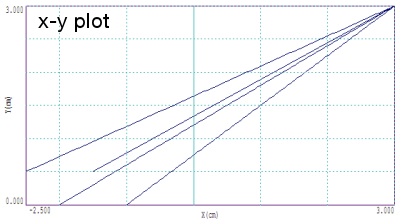I recently had questions from two Trak users who thought they had observed non-physical particle orbits. Particles were repelled from the axis in cylindrical calculations, even when there were no applied electric or magnetic fields.
The explanation is simple, but was was not apparent to the users because the orbits occurred in complex simulations with multiple electrodes and magnetic focusing fields. Consider the radial equation of motion for a constant-energy particle:
γm d2r/dt2 = Fr + γm v^2/r.
The second term on the right-hand side is the centrifugal force. If the forces are azimuthally symmetric (a requirement for the 2D Trak code), then canonical angular momentum is a conserved quantity:
Pθ = γm r vθ.
We can rewrite the first equation as
γm d2r/dt2 = Fr + Pθ^2/(γm r^3)
There is a virtual force with a strong radial variation that appears to repel particles with non-zero canonical angular momentum from the axis in a z-r plot. The orbits look less mysterious when plotted in Cartesian coordinates. Figure 1 shows a projection of bouncing orbits to a plane normal to the z axis (y versus x). In this view, motion in the field-free region is along straight lines.
Part of the problem was that the users did not realize that their particles had non-zero initial values of azimuthal velocity. Here are some instances where particles gain vθ:
- Motion through a solenoid lens.
- Adding a thermal spread to particles generated from an emission surface.
- Starting particles from a list with initial velocities such that vyi/vxi ? yi/xi.

Figure 1. Particles in free space, x-y plot.
LINKS